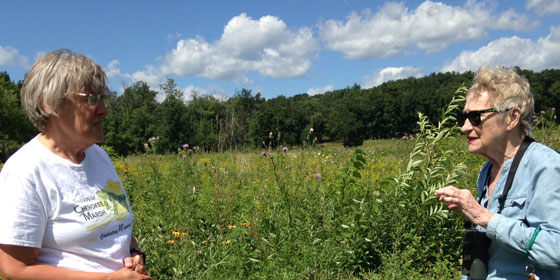Anita Weier
(A version of this article appeared in the Northside News.)
Jan Axelson credits her dedication to protecting and restoring Cherokee Marsh to her enjoyment of Wisconsin’s natural wonders after moving to Madison from New Jersey for college. “I had no mentors growing up regarding environmental activism,” she said. “I credit Wisconsin with giving me an environmental consciousness.”
Dorothy Wheeler did have a mentor – her father Richard A. Hemp, who served on the state Natural Resources Board and loved the outdoor world. She recalls the polluted Wisconsin River that flowed through the paper mill town where she lived and how it got cleaned up after laws were passed that made dumping waste into the river illegal.
Both women have served on the Board of the Friends of Cherokee Marsh for 10 years – ever since the organization was started to protect the marsh from development. (Two others, Janet Battista and Muriel Simms, have served for nine years.) All four are Northsiders.
Jan moved to the Cherokee Park neighborhood in 2000, in part to be close to the marsh for kayaking, canoeing, hiking, skiing and bird watching.
Then in 2006, the City of Madison was working with developer Cherokee Park, Inc. to provide recommendations for land use and development on the company’s land in the marsh area. “There were concerns about preserving the wetlands,” she recalled. First a steering committee met and then the Friends of Cherokee Marsh formed as a nonprofit in 2007. Axelson has been president for eight years.
The Friends have broadened their involvement, advocating for the city to acquire more land for the marsh. So far, more than 360 acres have been acquired and added to Cherokee Marsh Conservation Park.
An original informal group of about 20 people has grown into a membership of 200 that this year celebrated the Friends’ 10th anniversary. Volunteer projects include restoring native plant communities and keeping close track of proposed developments so they do not hurt the marsh.
“Cherokee Marsh is by far the biggest conservation park in the city, with three units: North, South and Mendota. State and county land adds to the total,” Axelson said. “The wetlands at the head of the chain of lakes reduce flooding by storing storm water and releasing it slowly. The marsh provides food and shelter for birds and other wildlife, as well as a place for recreation and reflection by humans.”
Dorothy, who has lived on the Northside since 1966, was an advisory member of the Friends board while she served on the Dane County Board from 2004 to 2010 and has continued as a board member since.
Wheeler says that public purchases and protection of environmentally significant land is vital. She also led the fight to protect Lake View Hill from development by turning it into a county park that was declared a conservancy.
“Our environment is so beautiful – green and lush,” she said. “It wouldn’t matter how many good things we did if the environment was wrecked.”
Major achievements of the group so far have been establishing a permanent Cherokee Marsh Conservation Fund, financing school children’s trips to the marsh for environmental education, and establishing relationships with state, city and county land managers. “We are a source of volunteers for them as well as providing input,” Axelson explained.
The Friends also sponsor a candlelight walk in the winter and monthly bird and nature walks.
“We welcome new participants in the Friends and the Friends Board. Interested people are invited to come to our meetings at 5:30 p.m. on the third Wednesday each month at the Warner Park Community Recreation Center,” she said. Dues for the Friends cost $15 for an individual or $25 for a family. Joining up is easily done on cherokeemarsh.org.
“We are all-volunteer, so what we can accomplish depends on the skill, time and interest of volunteers. That’s why it is vital to have an active group of people volunteering – whether it be one time or ongoing.”

